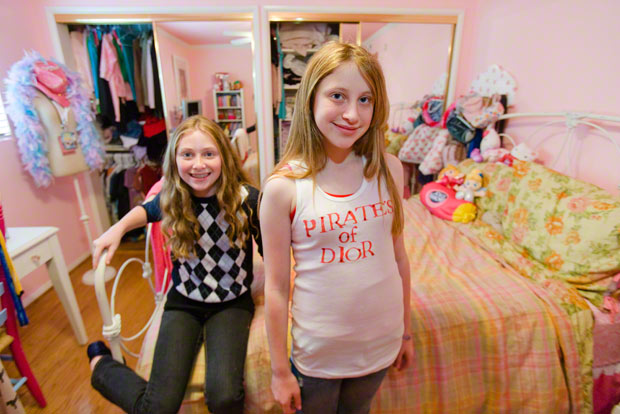
Specialist Misha Pemble-Belkin (l.) and Ross Murphy (r.) of Battle Company, 173rd US Airborne relax at Outpost Restrepo. Korengal Valley, Afghanistan, Kunar Province. 2008. Photograph © Tim Hetherington
“Witnesses in Action,” the documentary film series I curated earlier this month, followed the lenses of brave and talented photographers who took their cameras to far-flung locales. We started in mile-long factories in China, travelled to bizarre beached shipwrecks in Pakistan, hid under the jackets of citizen journalists in Burma, peeked into kids’ closets in Los Angeles, followed hungry teens in Seattle, and then catapulted to war-ravaged Iraq and army barracks and firefights in Afghanistan, and ended our journey in Kosovo and at mines in Indonesia.
You can make this journey, too, by holding your own international doc fest at home. Almost all of the films are available on DVD or through video-on-demand channels.
The series complemented the photojournalism exhibition Engaged Observers: Documentary Photography since the Sixties, which provided a multitude of thematic entrance points. Here are the seven films I chose—and why.
Seattle and L.A.: Streetwise and Kids + Money
Streetwise (1984) and Kids + Money (2008) have a direct correlation to Mary Ellen Mark’s and Lauren Greenfield’s photographic projects that are featured in the exhibition. The films animate the lives of teenagers who inhabit two entirely different socioeconomic worlds—the gritty streets against the shiny shopping mall.
Streetwise is currently only available on VHS, but since it was recently remastered, we’re hoping for a re-release.

Kids + money: Megan, 11, and Ashley, 13, at their Calabasas home. Photograph by Lauren Greenfield/ INSTITUTE
China: Manufactured Landscapes
I selected Manufactured Landscapes (2007), Jennifer Baichwal’s documentary about macroscopic photographer Edward Burtynsky, not only because it offered a portrait of the photographer at work, but also because it explored the human face of industrialization in China in the midst of horrifyingly vast mechanized landscapes of production. I wanted to draw out some of the concerns that photographers such as Sebastião Salgado and W. Eugene and Aileen M. Smith have raised about globalization, industry, and the people most affected by their hidden dangers.
Iraq and Afghanistan: Iraq in Fragments and Restrepo
It was hard to identify a documentary film to complement Philip Jones Griffiths’s seminal photographs of the Vietnam War featured in Engaged Observers. I located The Anderson Platoon (1967), an Academy Award-winning precursor to Restrepo, whose director followed a platoon through the jungles and cities of Vietnam for six weeks, heavy film camera and reels in tow. But while it’s an important historical document, it wasn’t quite right for the series with its voice-over narrative and blurry imagery.
Instead, I thought it better to showcase some of the extraordinary films that have been made about our current, ongoing wars. Iraq in Fragments (2006) and Restrepo (2010) were juxtaposed in a double feature. Both films’ directors were embedded with U.S. units for extended periods, and both used verité-style approaches. Iraq in Fragments is more cinematographically poetic, and trails Iraqi citizens after the fall of Baghdad; Restrepo uses a more raw approach, and follows U.S. soldiers at a remote and dangerous Afghan outpost.
Restrepo is still in the midst of its theatrical run, but the DVD is available for pre-order.
Burma: Burma VJ
The two remaining films in the series tackled the ethics of reportage head-on. While most of the films were made with cameras that were, in some way, welcomed or acknowledged by the photographed subjects, Burma VJ (2009) showed us what happens when cameras and image-makers are outlawed by a violently repressive political regime. To me, Burma’s anonymous video journalists represent the core of the photographer’s drive—the impulse to photograph, no matter the risk.
Kosovo, the West Bank, and Indonesia: War Photographer
The series ended with War Photographer (2001), a portrait of James Nachtwey, whose work is also featured in Engaged Observers. By watching him at work in the field, we discover his moral coda and come to understand his approach to balancing the pursuit of the perfect picture with an ethical commitment to tell difficult stories that are otherwise forgotten.

James Nachtwey in the field. Photo © Christian Frei Filmproductions
We were fortunate to have the company of three visionary film directors at the screenings. Lauren Greenfield (Kids and Money), Martin Bell (Streetwise), and Tim Hetherington (Restrepo) offered rich perspectives on the art and heart of their films.
Even though you won’t have a director Q&A in your living room if you watch these films at home, I hope you’ll enjoy their powerful stories as much as much as our audience did during the series.




Comments on this post are now closed.